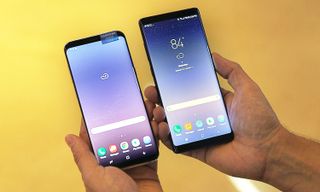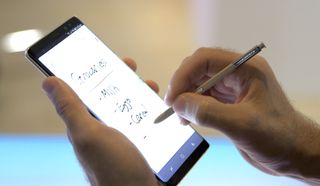Galaxy Note 8 Hands-on: A Dual-Camera Multitasking Beast
The Galaxy Note 8 boasts dual cameras, nifty S Pen improvements and a big 6.3-inch screen in a fairly compact design. But is that enough?
Samsung’s long-awaited sequel to the explosive Note 7 is here, and it looks like one of the strongest Android phones yet, especially for power users. But it commands a serious premium, with a full retail price that's between $930 and $960 (or a bit over $30 per month to $40 per month).
We went hands-on with the new Note 8 and checked out its features, from its large 6.3-inch display and improved S Pen to its powerful dual cameras — a first for Samsung phones. Here are eight things you should know about the Note 8, which will be available for pre-orders starting Aug. 24, and will go on sale Sept. 15.
It’s big at 6.3 inches, but not too big

The Note 8 is a smidgen wider and taller than the Galaxy S8+; I was initially concerned that my hands, big as they are, would still not be able to wrap around the Note 8’s 6.3-inch Infinity Edge screen. However, the phone was comfortable to hold in one hand; the curved sides of the Note 8, while not as pronounced as the S8+, certainly help with that.
Measuring 6.4 x 2.9 x 0.34 inches, the Note 8 is just a hair larger than the S8+ (6.3 x 2.9 x 0.3 inches) and longer, but narrower, than the iPhone 7 Plus (6.2 x 3.1 x 0.29 inches). The difference in thickness really made a difference, as it was much easier to stretch my thumb across the Note 8’s display than on the 7 Plus.
Weighing in at 6.9 ounces, though, the Note 8 is considerably heavier than the iPhone 7 Plus (6.6 ounces) and the S8+ (6.1 ounces).
Like the S8, the Note 8 is IP68-rated, which means it can be submerged in up to 5 feet of water for up to 30 minutes. And in the case of the Note 8, that’s regardless of whether the pen is inserted.
Galaxy Note 8 Specs at a Glance
| Screen Size/Resolution | 6.3 inches/2960 x 1440 Quad HD+ Super AMOLED |
| Processor | Qualcomm Snapdragon 835 |
| RAM | 6GB |
| Internal Storage | 64GB |
| Water Resistance | IP68 (5 feet/30 minutes) |
| Front Camera | 8MP f/1.7 |
| Rear Cameras | 12MP f/1.7 wide angle; 12MP f/2.4 telephoto (2x zoom) |
| Size | 6.4 x 2.9 x 0.34 inches |
| Weight | 6.9 ounces |
| Battery | 3300 mAh |
The S Pen is mightier

The S Pen in the Note 8 has the same level of pressure sensitivity as the Note 7 (4,096 levels), which made for a very natural writing experience in my hands-on time. But what’s new? The Screen Off Memo feature introduced with the Note 7, which lets you start writing on a locked display, now lets your write up to 100 pages of notes.
Live Messages is another fun new feature. You can draw or write something on the screen, and the Note 8 will create an animated GIF, which you can then send to others. Plus, the GIF is stored on the phone, which will allow you to use it anywhere you choose. After writing “Hello” on screen, the app took about a second or two to create the GIF, so there’s not much of a wait time.
The S Pen’s translation features have also been boosted; you can now use it to translate entire sentences, rather than just individual words. It will work with 71 languages, and can convert units and foreign currencies.
The S Pen itself is 4.25 inches long and 0.23 inches at its widest; it’s definitely a delicate little instrument, but it was easy to hold as I jotted things on the Note 8’s display.
Dual cameras are twice as nice

Like the S8+, the Note 8 has a wide-angle 12-megapixel f/1.7 rear camera (with a 77-degree field of view), but sitting next to it is a second 12-MP f/2.4 telephoto lens, which has a 2X optical zoom, and a 10X digital zoom (and a 45-degree FOV). We were hoping for a 3x zoom, which would have trumped the iPhone 7 Plus, but it’s good to see Samsung catching up to what other phone makers offer. In one respect, Samsung has jumped ahead, as both of its cameras have optical image stabilization; only one of the 7 Plus’ rear cameras has this feature.
As with the iPhone 7 Plus, the Note 8’s dual cameras allow you to blur the background (the official term is “bokeh”) when taking portraits. You can adjust the amount of blur, both before and after you take the photo. To use this feature, you must be in the Live Focus mode, and at least 4 feet from your subject.
In my hands-on time, the Note 8 had a bit of trouble figuring out what was the background and what wasn’t; some of the edges of foreground objects were slightly blurred.
An optional Dual Capture mode on the Note 8 lets you snap both a zoomed-in photo and a wider- angle shot at the same time. Samsung said this is to let you capture both a close-up of a person, but not miss out on the wider vista behind them. It’s a good idea in theory, but when I tried it out, I found that you can’t compose a shot well for both the zoomed-in and wider-angle pictures at the same time. For example, I composed a close-up with the subject right where I wanted it, but the wider-angle photo did not have the subject in the spot I would have chosen.
MORE: Best Smartphone Cameras
App Pair is an easier way to multitask

At 6.3 inches, the Quad HD+ Super AMOLED display on the Note 8 is a hair larger than the S8+’s 6.2-inch screen, and dwarfs the iPhone 7 Plus’ 5.5-inch, 1920 x 1080 panel. The Note 8 will still be the largest out there, regardless of which iPhone 8 rumor you believe, too. However, unlike Apple’s phone, the Note 8 does not have a pressure-sensitive display, as some rumors had suggested.
You’ll be able to do some cool things with that extra real estate, though. For example, a new Apps Edge feature called App Pair will let you group two apps together and launch them simultaneously side by side. That’s a good time-saver for multitaskers.
It has slightly more power
Like the S8, the Note 8 is powered by a Qualcomm 835 processor. At our briefing, Samsung representatives would only identify it as a 10nm processor, but acknowledged it was the same in both phones. However, the Note 8 will come with 6GB of memory, up from the 4GB in the S8. That will most certainly keep it at the head of the Android flagship performance pack, or put it on the same level as the OnePlus 5, which outpaces all other smartphones we've tested.
Also, like the S8, the Note 8 has 64GB of internal storage, which can be expanded to 256GB via a microSD card.
How safe is the battery, and how long will it last?
After last year’s fiasco with the Note 7, Samsung is taking extra steps to ensure that the same thing doesn’t happen to the Note 8. So, in addition to the usual testing, Samsung told us that it developed additional tests with Underwriters Laboratories, as well as an eight-part battery safety test that starts in the factory.
But what about battery life? The Note 8 will have a 3,300 mAh battery, which is smaller than the S8+’s 3,500 mAh battery. Still, the S8+ had a smaller battery than its predecessor, and still managed a better runtime of 11 hours and 4 minutes on the Tom’s Guide Battery Test. The regular S8, which has a 3,000 mAh battery, lasted 10 hours and 39 minutes on the same test. Anything longer than 9.5 hours is very good.
Same fingerprint reader

Nothing new here; the Note 8 has the same fingerprint sensor as the S8+, whose placement on the rear of the phone, next to the camera, remains inconvenient. The Note 8 also has face- and iris- recognition, features found on the S8+.
Limited color options—for now
U.S. customers will be able to purchase only a black or a gray version of the Note 8, even though Samsung is also making a gold version and a blue version. It’s a shame, because the blue model was a treat to look at. Regardless of the color you pick, though, the reflective surface of the Note 8 makes it a real fingerprint magnet.
Outlook
Given the popularity of Samsung’s previous Note smartphones, it’s safe to say that the Note 8 will appeal to those who are looking for a device that makes it easy to jot down items, sketch ideas or use other pen-enabled apps. The Note 8 also looks like a fine choice for anyone who wants the biggest screen phone in the Galaxy at 6.3 inches. You just need to decide if the Note 8 is worth about $100 more than the Galaxy S8+.
Although the Note 8 is indeed a large device, it’s still thin enough to hold in one hand — easier than previous Note smartphones — and the ability to take up to 100 pages of notes with the phone locked is a plus. Compared with the iPhone 7 Plus, the dual cameras on the Note 8 feel like a keeping-up-with-the-Joneses feature at first glance, but this camera stands out by letting you tweak the bokeh effect before and after the shot. Plus, both cameras have OIS, while the iPhone 7 Plus' telephoto lens doesn't offer that feature.
We’re cautiously optimistic about the Note 8’s battery life, as it should fall somewhere between the Galaxy S8 and the S8+. Provided that it does, Samsung should have another great smartphone on its — and in your — hands.
Sign up to get the BEST of Tom’s Guide direct to your inbox.
Upgrade your life with a daily dose of the biggest tech news, lifestyle hacks and our curated analysis. Be the first to know about cutting-edge gadgets and the hottest deals.

Michael A. Prospero is the U.S. Editor-in-Chief for Tom’s Guide. He oversees all evergreen content and oversees the Homes, Smart Home, and Fitness/Wearables categories for the site. In his spare time, he also tests out the latest drones, electric scooters, and smart home gadgets, such as video doorbells. Before his tenure at Tom's Guide, he was the Reviews Editor for Laptop Magazine, a reporter at Fast Company, the Times of Trenton, and, many eons back, an intern at George magazine. He received his undergraduate degree from Boston College, where he worked on the campus newspaper The Heights, and then attended the Columbia University school of Journalism. When he’s not testing out the latest running watch, electric scooter, or skiing or training for a marathon, he’s probably using the latest sous vide machine, smoker, or pizza oven, to the delight — or chagrin — of his family.
